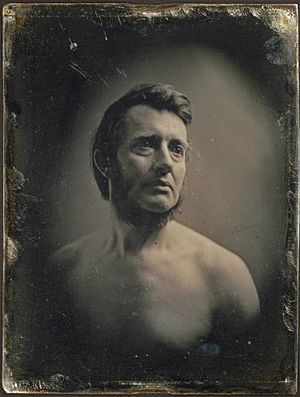Albert Southworth facts for kids
Albert Sands Southworth (1811–1894) was a famous American photographer. He worked with Josiah Johnson Hawes (1808–1901) to create the well-known Southworth & Hawes studio. This studio specialized in daguerreotypes, an early type of photograph, from 1843 to 1863.
Contents
Early Photography Pioneers
Learning from a Master
Albert Southworth learned photography from Samuel F.B. Morse. Morse is famous for inventing the telegraph. But he was also very interested in daguerreotypes, which were the first successful photographs.
The Southworth & Hawes Studio
Southworth and Hawes opened their photography studio in Boston. It was on the top floor of a building. The studio had huge skylights. These let in a lot of natural light. This light was very important for taking clear pictures. It helped make the exposure time shorter for portraits.
They made many different sizes of daguerreotypes. Some were small, like a locket. Others were stereoscopic images, which gave a 3D effect. However, they were best known for their "whole plate" images. These were quite large for a daguerreotype, measuring about 6.5 by 8.5 inches (16.5 by 21.6 cm). Taking such large photos was expensive at the time.
Famous Faces and Clients
Many important people came to the Southworth & Hawes studio. These included famous figures like lawmaker Daniel Webster. Author Harriet Beecher Stowe, who wrote Uncle Tom's Cabin, also sat for them. Reformer Dorothea Dix, known for her work with mental health, was another client. They also photographed local business people and other citizens from Boston.
Southworth & Hawes were not the only photographers in Boston. Other well-known daguerreotypists included Masury & Silsby and John Adams Whipple. The studios of Whipple and Southworth & Hawes were the biggest in Boston. In America, only the New York studios of Mathew Brady and M.M. Lawrence became larger after 1853.
Clever Inventions
Southworth & Hawes also invented some interesting devices. One was called the "grand parlor stereoscope". You could turn a crank to see new daguerreotype views. It was a bit like an early version of a View-master. They had one of these devices in their studio's waiting room. It helped entertain their customers.
Later, in 1855, Southworth invented another device. This invention allowed photographers to take up to eight pictures of the same person. They could do this in just two steps. It worked by using a special lens system. This system exposed half of a large plate at a time.
See Also



